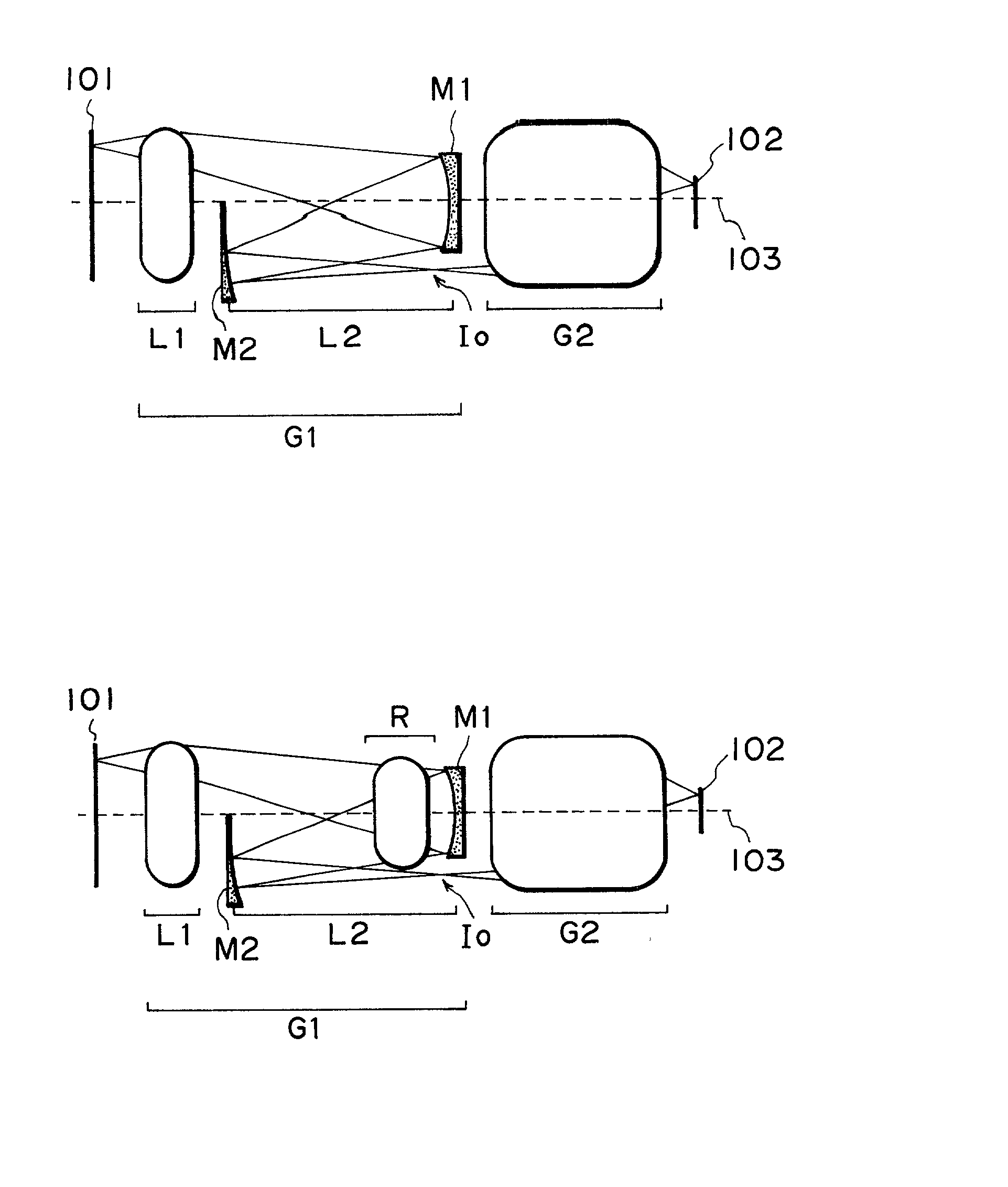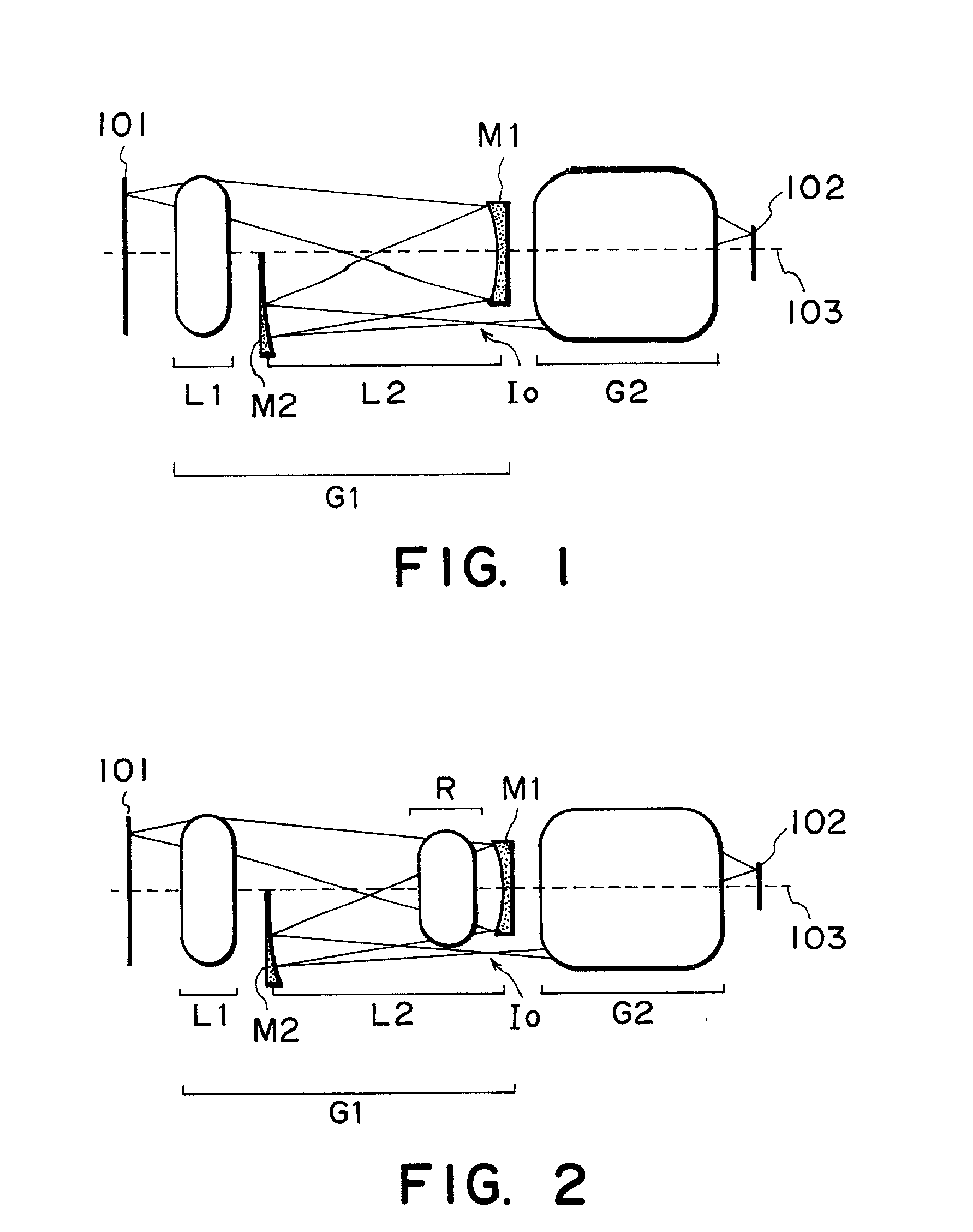Projection optical system and projection exposure apparatus
a technology of projection optical system and exposure apparatus, which is applied in the direction of photomechanical apparatus, instruments, lenses, etc., can solve the problems of difficult to achieve chromatic aberration correction, limited use of lens materials, thermal aberration,
- Summary
- Abstract
- Description
- Claims
- Application Information
AI Technical Summary
Problems solved by technology
Method used
Image
Examples
second embodiment
, respectively, to which the second embodiment is applied, to be described later. In all examples, the first imaging system Gr1 has two mirrors, and the second imaging system Gr2 comprises refractive lens systems only FIGS. 12-19 shows cases wherein the field optical system Grf is all provided by lens systems, and FIGS. 20-28 show cases wherein the field optical system Grf has two mirrors.
[0119] Generally, where a mirror is used, the optical system functions as follows.
[0120] (a) No chromatic aberration occurs at the mirror.
[0121] With this feature, when a concave lens and a concave mirror are combined to provide a Mangin mirror, even by a positive power, excessive dichromatism can be produced.
[0122] (b) The relation between the power of the mirror and the Petzval sum is opposite to that of an ordinary refractive lens.
[0123] With this feature, since a concave mirror, for example, has a negative value of Petzval sum while it has a positive power, the power load of a negative lens in ...
example 1
[0165] FIG. 4 shows a specific lens structure of Example 1. The projection magnification was 1:4, and the design base wavelength was 157 nm. The glass material was fluorite.
[0166] The projection optical system comprises, in an order from the object side, a refractive lens group L1 having a positive refracting power, a refractive lens group R which is a reciprocal optical system wherein both the incidence light and reflection light of a first mirror M1 (to be placed later) transmit therethrough, a concave mirror (first mirror) M1, a concave mirror (second mirror) M2, a field lens group F, and a second imaging optical system G2.
[0167] In this embodiment, the image side numerical aperture was NA=0.6, the reduction magnification was 1:4, and the object-to-image distance (from the first object plane to the second object plane) was L=about 1170 mm. The design base wavelength was 157 nm. In the range of the image height of about 11.25-19.75 mm, the aberration was corrected. An abaxial expo...
example 2
[0175] FIG. 5 shows a specific lens structure of Example 2. The projection magnification was 1:4, and the design base wavelength was 157 nm. The glass material was fluorite.
[0176] The projection optical system comprises, in an order from the object side, a refractive lens group L1 having a positive refracting power, a refractive lens group R which is a reciprocal optical system wherein both the incidence light and reflection light of a first mirror M1 (to be placed later) transmit therethrough, a concave mirror (first mirror) M1, a flat mirror (second mirror) M2, a field lens group F, and a second imaging optical system G2.
[0177] In this embodiment, the image side numerical aperture was NA=0.60, the reduction magnification was 1:4, and the object-to-image distance (from the first object plane to the second object plane) was L=about 1205 mm. In the range of the image height of about 10-16.25 mm, the aberration was corrected. An abaxial exposure region of arcuate shape, having at leas...
PUM
| Property | Measurement | Unit |
|---|---|---|
| exposure wavelength | aaaaa | aaaaa |
| wavelength | aaaaa | aaaaa |
| distance | aaaaa | aaaaa |
Abstract
Description
Claims
Application Information
 Login to View More
Login to View More - R&D
- Intellectual Property
- Life Sciences
- Materials
- Tech Scout
- Unparalleled Data Quality
- Higher Quality Content
- 60% Fewer Hallucinations
Browse by: Latest US Patents, China's latest patents, Technical Efficacy Thesaurus, Application Domain, Technology Topic, Popular Technical Reports.
© 2025 PatSnap. All rights reserved.Legal|Privacy policy|Modern Slavery Act Transparency Statement|Sitemap|About US| Contact US: help@patsnap.com



